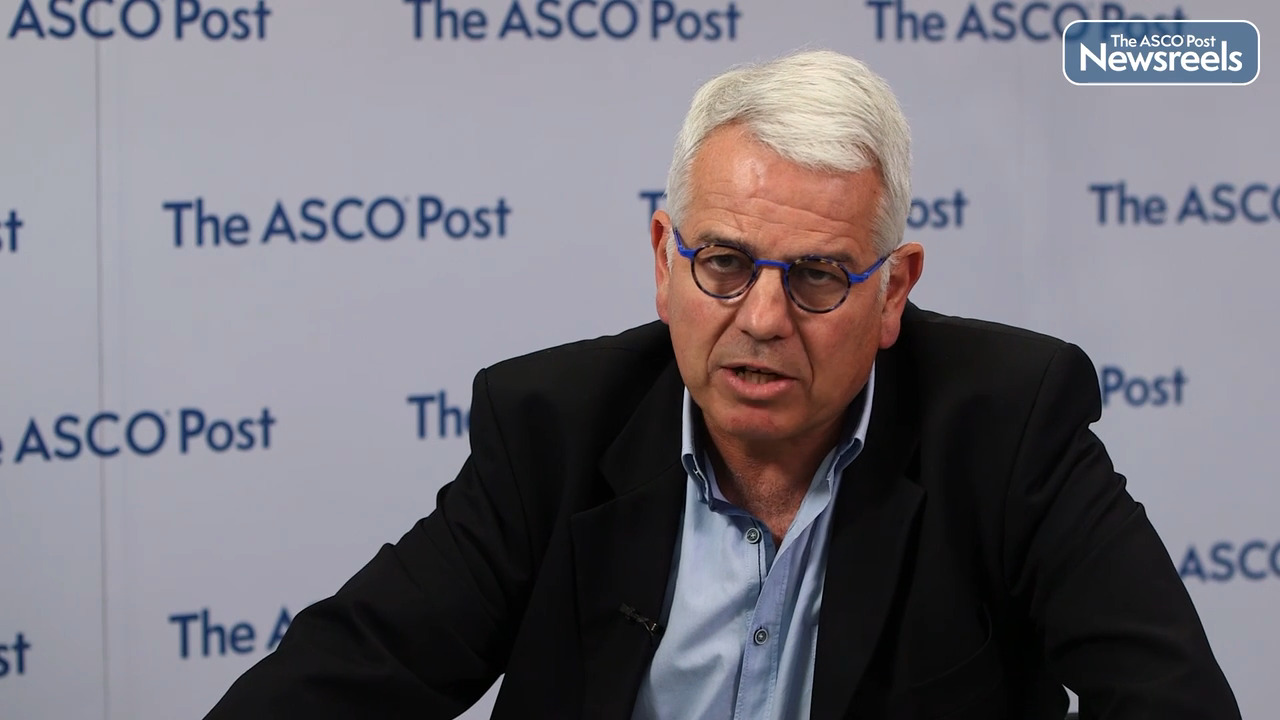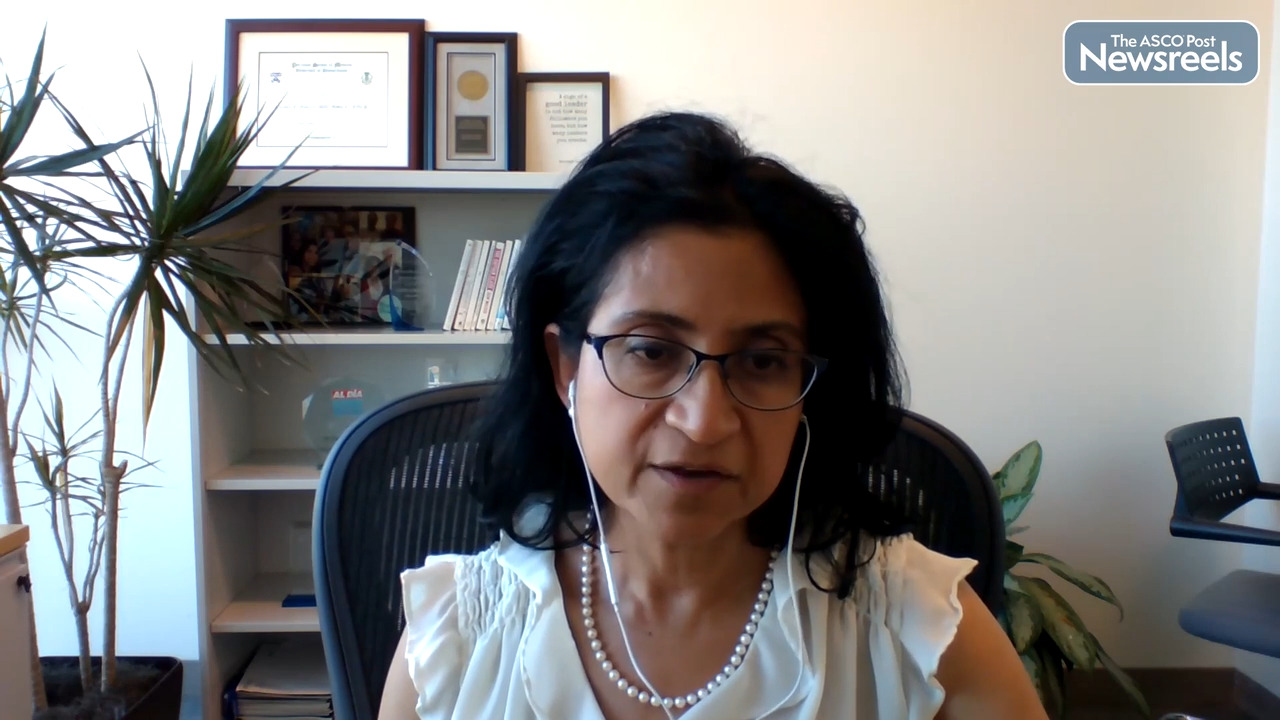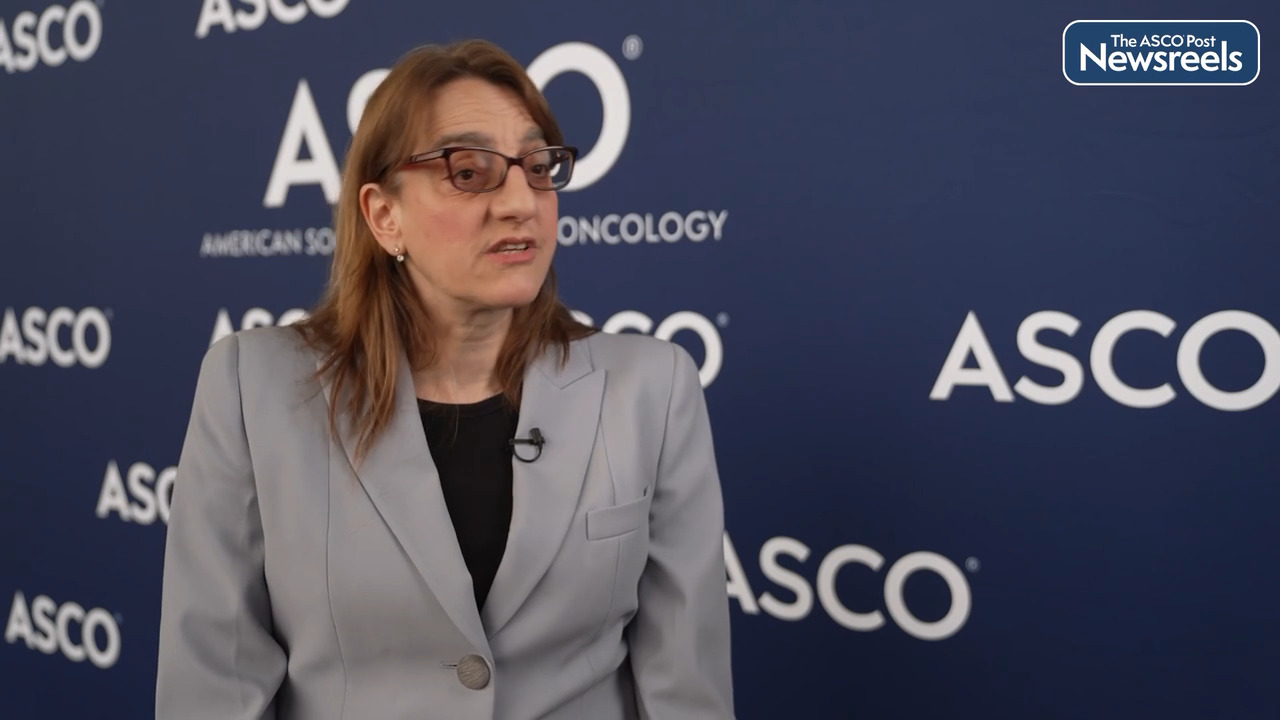Shilpa Gupta, MD, on Urothelial Carcinoma: Long-Term Outcome of Enfortumab Vedotin Plus Pembrolizumab
2023 ASCO Annual Meeting
Shilpa Gupta, MD, of Cleveland Clinic, discusses the results from the EV-103 study and the unmet need for effective first-line therapies in cisplatin-ineligible patients with locally advanced or metastatic urothelial carcinoma. After nearly 4 years of follow-up, the trial findings showed that enfortumab vedotin-ejfv plus pembrolizumab continues to demonstrate promising survival trends with rapid and durable responses in this population (Abstract 4505).
Transcript
Disclaimer: This video transcript has not been proofread or edited and may contain errors.
Shilpa Gupta, MD:
We are reporting the four-year follow-up of EV103 dose escalation in cohort A. This was the study in locally advanced and metastatic urothelial cancer patients who are ineligible to receive cisplatin and received a combination of enfortumab vedotin and pembrolizumab. Enfortumab vedotin is an ADC, which is already approved in the refractory setting in metastatic urothelial cancer. Previous data has led to the X-rated approval of this combination in this setting. This is the long-term data that is being reported, and we saw that the response rates by BICR was 73.3%. Median overall survival was 26 months at a median follow-up of 47 months. Median progression-free survival was 12.7 months, and the tail of the curve is still holding strong, and this is really important results for these patient populations where historically, the median overall survival used to be six to nine months.
There were no new signals of toxicity. The key toxicities that we saw with the combination were rash, peripheral neuropathy, fatigue, and these are all manageable. If dose reductions and dose discontinuations are done appropriately, these toxicities do tend to resolve. For example, the rash and the hyperglycemia tend to occur early and resolve very early if dose reductions and dose discontinuations or treatment breaks are given. Peripheral neuropathy takes some time to manifest, around 2.7 months at the median, and can resolve by seven months with dose reductions. We really need to be cautious of these toxicities and manage the patients appropriately, but this is really very important data for this patient population, and the ongoing phase three study of EV302, which is looking at this combination versus standard of care gemcitabine cisplatin, or gemcitabine carboplatin will further establish its efficacy across the board.
The ASCO Post Staff
Jennifer L. Crombie, MD, of Dana-Farber Cancer Institute, discusses the historically poor outcomes for patients with relapsed or refractory diffuse large B-cell lymphoma (DLBCL). Her study examined real-world data on the use of novel therapies in this population and found that outcomes with second- and third-line regimens of polatuzumab vedotin-piiq plus bendamustine and rituximab and tafasitamab plus lenalidomide remain suboptimal, with worse outcomes particularly after chimeric antigen receptor T-cell therapy (Abstract 7552).
The ASCO Post Staff
Christian Pfister, MD, PhD, of Rouen University Hospital, discusses phase III results from the VESPER trial, which showed that dose-dense methotrexate, vinblastine, doxorubicin, and cisplatin provided a better overall survival rate at 5 years and improved disease-specific survival compared with gemcitabine as perioperative chemotherapy in patients with muscle-invasive bladder cancer (Abstract LBA4507).
The ASCO Post Staff
Tycel J. Phillips, MD, and Swetha Kambhampati, MD, both of City of Hope National Medical Center, discuss new findings showing that the real-world effectiveness and safety of brexucabtagene autoleucel were similar to data from the pivotal ZUMA-2 trial in patients with relapsed or refractory mantle cell lymphoma, regardless of prior BTK inhibition, bendamustine, or autologous stem cell transplantation (Abstract 7507).
The ASCO Post Staff
Carmen E. Guerra, MD, MSCE, of the University of Pennsylvania Abramson Cancer Center, discusses three key abstracts presented at ASCO: strategies to increase accrual of underrepresented populations in Alliance NCTN trials, how patient-clinician education can strengthen partnerships and improve diversity in breast and lung cancer trials, and mediators of racial and ethnic inequities in clinical trial participation among U.S. patients with cancer from 2011 to 2022 (Abstracts 6509, 6510, 6511).
The ASCO Post Staff
Funda Meric-Bernstam, MD, of The University of Texas MD Anderson Cancer Center, discusses interim results from the DESTINY-PanTumor02 trial, the first tumor-agnostic global study of fam-trastuzumab deruxtecan-nxki (T-DXd) in a broad range of HER2-expressing solid tumors. This agent showed an encouraging overall response rate, particularly in patients with IHC 3+ expression; durable clinical benefit; and a manageable safety profile in these heavily pretreated patients. T-DXd may be a potential new treatment option for this population (Abstract LBA3000).





